Related Research Articles

Anna Pavlovna of Russia was Queen of the Netherlands by marriage to King William II of the Netherlands. She was a Russian patriot who upheld a strict royal etiquette in the Netherlands, where she never felt at home, and identified more as an Imperial Russian grand duchess than a Dutch queen. She had no political influence, but was active within charity.

William I was King of Württemberg from 30 October 1816 until his death.
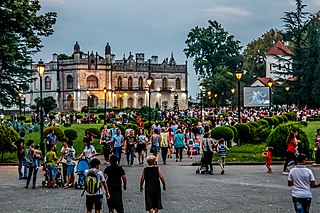
Zugdidi is a city in the western Georgian historical province of Samegrelo (Mingrelia). It is situated in the north-west of that province. The city is located 318 kilometres west of Tbilisi, 30 km from the Black Sea coast and 30 km from the Egrisi Range, at an elevation of 100–110 metres above sea level. Zugdidi is the capital of the Samegrelo-Zemo Svaneti region, which combines Samegrelo (Mingrelia) and upper part of Svaneti, and the centre of the Zugdidi Municipality within. Zugdidi is the sixth most populous city in Georgia.
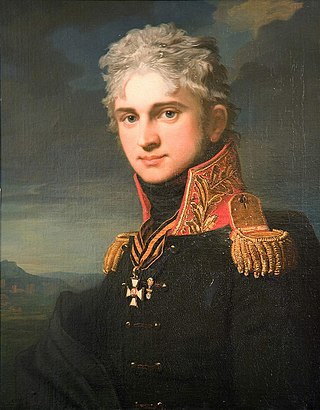
Count Pavel Alexandrovich Stroganov was a Russian military commander and statesman, Lieutenant General, Adjutant General to Alexander I of Russia. He took part in the Privy Committee that outlined Government reform of Alexander I.

Beloselsky Belozersky Palace is a Neo-Baroque palace at the intersection of the Fontanka River and Nevsky Prospekt in Saint Petersburg, Russia.

Maria Pavlovna was a grand duchess of Russia as the daughter of Paul I, Emperor of all the Russias, and later became the Grand Duchess of Saxe-Weimar-Eisenach by her marriage to Charles Frederick of Saxe-Weimar-Eisenach (1783–1853).
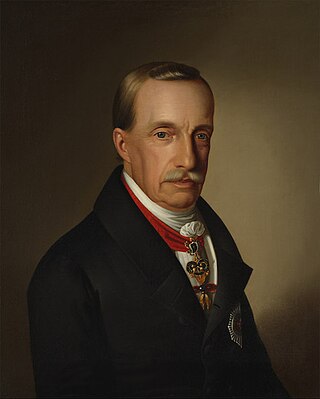
Archduke Joseph Anton of Austria was the 103rd and penultimate palatine of Hungary who served for more than fifty years from 1796 to 1847, after he had been appointed governor in 1795.

Elena Pavlovna was a grand duchess of Russia as the daughter of Paul I, the Russian emperor, and later became the Hereditary Grand Duchess of Mecklenburg-Schwerin as the wife of the Hereditary Grand Duke Frederick Louis (1778–1819).

Okropir known in Russia as Tsarevich Okropir Georgievich Gruzinsky, was a Georgian prince royal (batonishvili) of the Bagrationi dynasty.

Count Pavel Sergeevich Potemkin, sometimes spelled Potyomkin or Potiomkin was a Russian statesman, soldier, and writer.

Grand Duchess Alexandra Pavlovna of Russia was a daughter of Emperor Paul I of Russia and sister of emperors Alexander I and Nicholas I. She married Archduke Joseph of Austria, Palatine of Hungary. Her marriage was the only Romanov-Habsburg marital alliance to date.

Following three consecutive partitions of Poland carried out between 1772 and 1795, the sovereign state known as the Polish–Lithuanian Commonwealth disappeared from the map of Europe. In 1918 following the end of World War I, the territories of the former state re-emerged as the states of Poland and Lithuania among others. In the intervening period, the territory of the former Polish–Lithuanian Commonwealth was split between the Austrian Empire, the Kingdom of Prussia and the Russian Empire. These powers subdivided the territories that they gained and created new toponyms for the territories conquered. The subdivisions created were complicated by changes within those empires as well as by the periodic establishment of other forms of the quasi-Polish provinces led by a foreign head of state.

The Russian Partition, sometimes called Russian Poland, constituted the former territories of the Polish–Lithuanian Commonwealth that were annexed by the Russian Empire in the course of late-18th-century Partitions of Poland. The Russian acquisition encompassed the largest share of Poland's population, living on 463,200 km2 of land constituting the eastern and central territory of the former commonwealth. The three partitions, which took place in 1772, 1793 and 1795, resulted in the complete loss of Poland's sovereignty, with its territory split between Russia, Prussia and Austria. The Napoleonic Wars saw significant parts of Prussia's and Austria's partitions reconstituted as the Duchy of Warsaw, most of which was then reconstituted as the Kingdom of Poland within the Russian Empire in 1815.
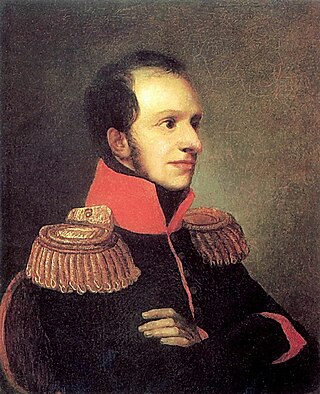
Duke Peter Frederick George of Oldenburg was a younger son of Peter I, Grand Duke of Oldenburg and his wife Duchess Frederica of Württemberg. He was a son-in-law of Paul I of Russia through marriage to his daughter Grand Duchess Catherine Pavlovna of Russia. He was referred to as a prince in Russia, Prince Georgy Petrovich Oldenburgsky.

Duke Constantine Frederick Peter of Oldenburg was a son of Duke Peter Georgievich of Oldenburg and his wife Princess Therese of Nassau-Weilburg Known in the court of Emperor Nicholas II as Prince Constantine Petrovich Oldenburgsky, he was the father of the Russian Counts and Countesses von Zarnekau.
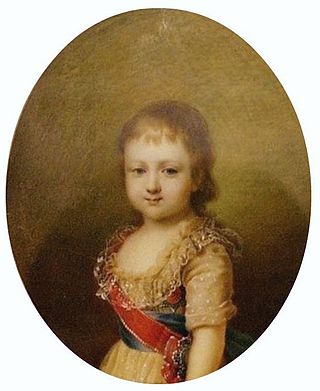
Grand Duchess Olga Pavlovna of Russia was a Grand Duchess of Russia as the second youngest daughter and seventh child of the Tsarevich of Russia and his consort, Sophie Dorothea of Württemberg.

Events from the year 1802 in Russia
Events from the year 1782 in Russia

The Poltoratsky family was a Russian noble family, descended from the Cossack Mark Fedorovich Poltoratsky (1729–1795), who during the reign of Catherine the Great, was in charge of the Court Singing Chapel. The Poltoratsky coat of arms shows a harp as a sign of this.
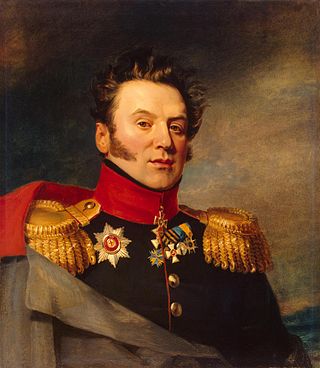
Konstantin Markovich Poltoratsky was a Yaroslavl Military and Civil Governor (1830–1842), lieutenant general of the Imperial Russian Army, a participant of five wars, including the French invasion of Russia.
References
- ↑ "Catherine the Great". Encyclopedia Britannica. Retrieved 23 May 2018.
- ↑ Dolan, Allison; Editors of Family Tree Magazine (2015). The Family Tree Historical Maps Book - Europe: A Country-by-Country Atlas of European History, 1700s-1900s. Family Tree Books. p. 283. ISBN 9781440342066 . Retrieved 2018-05-23.[ dead link ]
- ↑ "The National Library of Russia: Pride of Russian Culture". nlr.ru. Archived from the original on 24 May 2018. Retrieved 23 May 2018.
![]() Media related to 1795 in Russia at Wikimedia Commons
Media related to 1795 in Russia at Wikimedia Commons